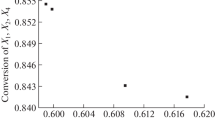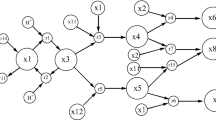Abstract
The main purpose of the study is to introduce the multi-objective optimization using Pareto approximations to problems of chemical kinetics. We report the setting up and solution of the multi-objective optimization problem for conditions of a chemical reaction on the basis of a kinetic model. The study addresses the reaction of alcohols with dimethyl carbonate catalyzed by cobalt or tungsten carbonyl. The objective functions for optimization of chemical reaction conditions based on a kinetic model are presented. The NSGA-II algorithm was applied to determine the Pareto set and front for the multi-objective optimization problem applied to the reaction of alcohols with dimethyl carbonate for two catalysts, which make it possible to find the compromise values of variable parameters providing extrema of the objective functions.




Similar content being viewed by others
Abbreviations
- DMC:
-
Dimethyl carbonate
- DM:
-
Decision maker
- t :
-
Time (min)
- νij :
-
Stoichiometric coefficients
- J :
-
Number of steps
- y i :
-
Concentration of a reactant, mol/l
- I :
-
Number of compounds
- wj :
-
Rate of j-th step (1/min)
- k j, k −j :
-
Rate constants of steps (reduced)
- E j :
-
Activation energy of reactions, kcal/mol
- G :
-
Universal gas constant, equal to 8.31 J/(mol K) or 0.002 kcal/(mol K)
- T :
-
Temperature (K)
- α ij :
-
Negative elements of the matrix (νij)
- β ij :
-
Positive elements (νij)
- k 0 j :
-
Pre-exponential factors, 1/min
- Z :
-
Optimization function
- y ct :
-
Amount of the catalyst, mmol
- y :
-
Concentration vector of a compound, mol/l
- y 0 :
-
Vector of initial concentrations of compounds, mol/l
- η :
-
Weight vector
- μ :
-
Additional expenses
- t*:
-
Reaction time (min)
- B :
-
Productivity [g/(l day)]
- N :
-
Number of cycles per day [day−1]
- \( \xi_{{X_{i} }} \) :
-
Reactant conversion
- \( M_{{X_{i} }} \) :
-
Reactant molar mass [g/mol]
- y prod :
-
Reaction product concentrations (mol/l)
- y source :
-
Reactant concentrations (mol/l)
- ψ :
-
Variable costs (normalized)
- A :
-
Fixed costs (normalized)
- Pr :
-
Number of products
- Sr :
-
Number of reactants
- P :
-
Profitability (normalized)
- X*:
-
Desired solution of multi-objective optimization problem over variable parameters
- F*:
-
Desired solution of multi-objective optimization problem over objective functions
- R |A| :
-
|A|-Dimensional arithmetic space
References
P.T. Anastas, J.C. Warner, Green chemistry: theory and practice (Oxford University Press, New York, 1998)
F. Arico, P. Tundo, Russ. Chem. Rev. 79(6), 479 (2010)
A.G. Shaikh, Chem. Rev. 96, 951 (1996)
R.I. Khusnutdinov, N.A. Shchadneva, Y.Y. Mayakova, Russ. J. Org. Chem. 50(6), 790–795 (2014)
K.F. Koledina, S.N. Koledin, N.A. Schadneva, Y.Y. Mayakova, I.M. Gubaydullin, Reac Kinet Mech Cat 121(2), 425–428 (2017)
K.F. Koledina, S.N. Koledin, N.A. Shchadneva, I.M. Gubaidullin, Russ. J. Phys. Chem. A 91(3), 444–449 (2017)
R.Z. Zainullin, K.F. Koledina, A.F. Akhmetov, I.M. Gubaidullin, Kinet. Catal. 58(3), 279–289 (2017)
E. Hairer, G. Wanner, Solving ordinary differential equations II, 2nd edn. (Springer, New York, 1996)
L.F. Shampine, R.M. Corless, J Comp Appl Math 125(1–2), 31–40 (2000)
M.M. Canedo, J.L. González-Hernández, J. Math. Chem. 49(1), 163–184 (2011)
K.F. Koledina, I.M. Gubaidullin, Rus J Phys Chem A 90(5), 914–921 (2016)
I.M. Gubaydullin, K.F. Koledina, L.V. Sayfullina, Eng J 18(1), 13 (2014)
L.F. Nurislamova, I.M. Gubaydullin, K.F. Koledina, R.R. Safin, React. Kinet. Mech. Catal. 117(1), 1–14 (2016)
A.P. Karpenko, Modern algorithms of search optimization. Algorithms inspired by nature: a tutorial (MSTU Publishing House. N.E. Bauman, Moscow, 2014)
M. Abramson, A. Charles, J.E. Dennis, J. Digabel, S. Digabel, SIAM J. Optim. 20(2), 948–966 (2009)
D. Kalyanmoy, A. Pratap, S. Agarwal, T. Meyarivan, IEEE Trans. Evol. Comput. 6(2), 182–197 (2002)
P. Alonso, F. Argüeso, R. Cortina, J. Ranilla, A.M. Vidal, J. Math. Chem. 51(4), 1153–1163 (2013)
P. Alonso, F. Argüeso, R. Cortina, J. Ranilla, A.M. Vidal, J. Math. Chem. 50(2), 410–420 (2012)
Acknowledgement
The reported study was funded by the President of the Russian Federation SP-669.2018.5 stipends and RFBR according to the research projects No. 18-07-00341, 18-37-00015.
Author information
Authors and Affiliations
Corresponding author
Rights and permissions
About this article
Cite this article
Koledina, K.F., Koledin, S.N., Karpenko, A.P. et al. Multi-objective optimization of chemical reaction conditions based on a kinetic model. J Math Chem 57, 484–493 (2019). https://doi.org/10.1007/s10910-018-0960-z
Received:
Accepted:
Published:
Issue Date:
DOI: https://doi.org/10.1007/s10910-018-0960-z




